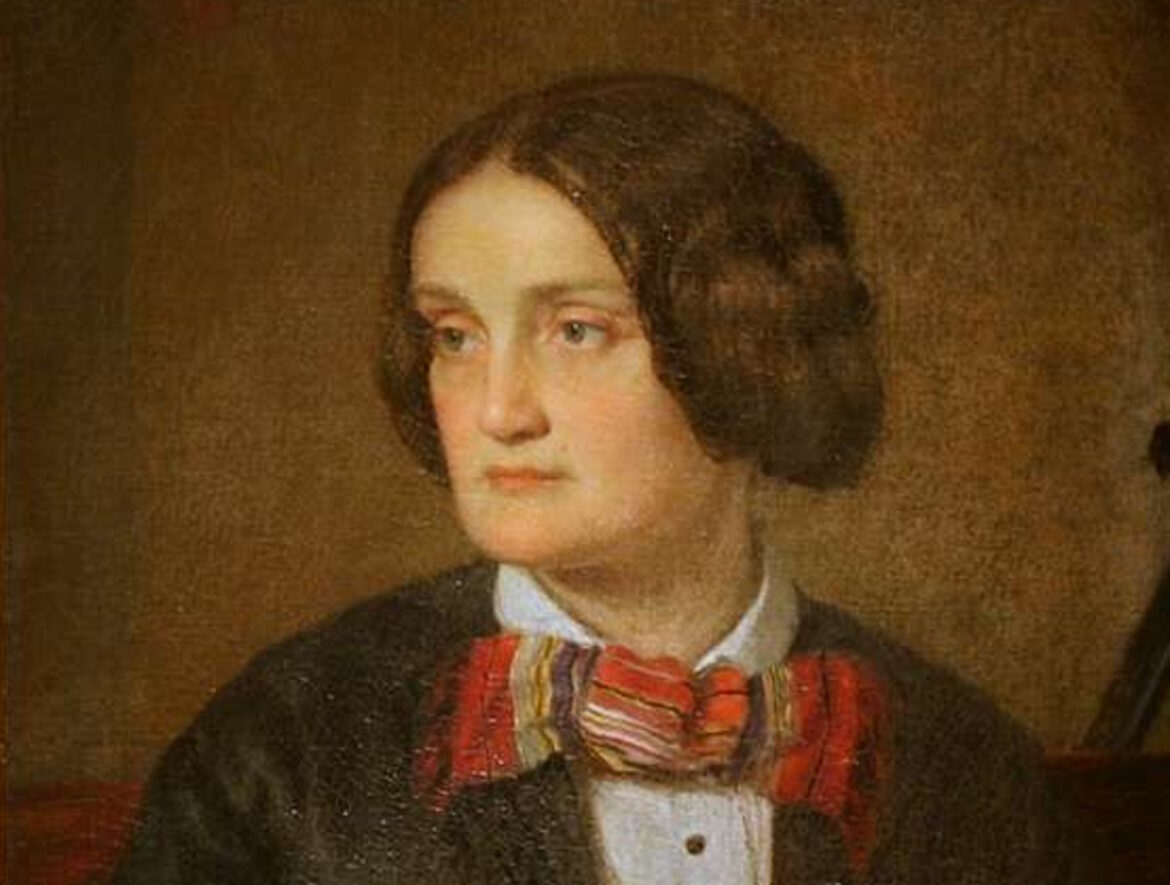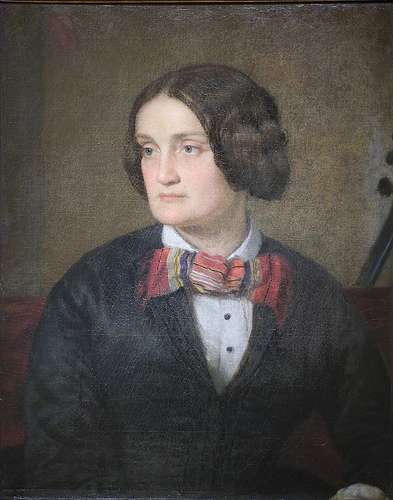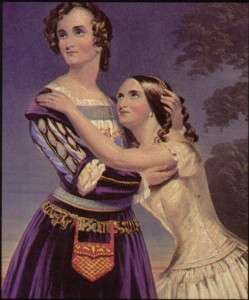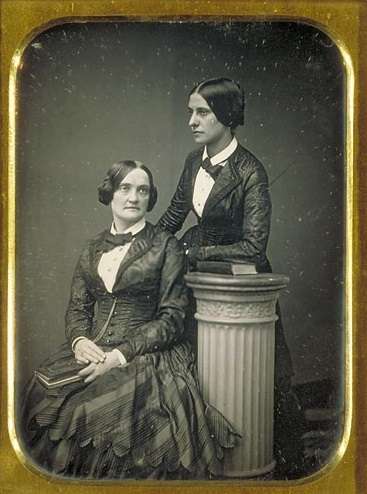Charlotte Cushman, considered the greatest actress in America during the mid-19th century, played both male and female dramatic roles. She did it on stage and in real life.
She carried on a series of romances with other women. She and one partner dressed alike and lived as a couple for 10 years in Europe. In the 1850s she set up a feminist household in Rome that attracted gay and straight women artists and writers.
Over her 40-year career she was one of the best known women in the English-speaking world. Many of her fans idolized her, and her retirement from the stage inspired a farewell ceremony described as ‘the most spectacular … in the history of the American theatre.’
Thousands of fans came in her honor to see fireworks and a candlelight procession through the streets of New York.
Biographer Lisa Merrill attributes part of Charlotte Cushman’s appeal to the strength of her character when the women’s rights movement gathered force.
And part of her appeal lay had to do with her disinterest in men. That absolved the theater of its tawdry reputation. Her flamboyant affairs were tolerated, argues Merrill, because people thought of women’s romantic friendships as chaste in the 19th century. Only men had physical desire, they thought.
After Charlotte Cushman died, attitudes about women’s friendships changed, and she fell into obscurity.
Weird Genius
In 1889, more than a decade after she died, Lawrence Barrett delivered a lecture trying to explain her success. Miss Cushman, he said, was ‘a woman of weird genius, somber imagination, great sensibility, and celibate condition.’ She was ‘victorious by force rather than by sweetness,’ he said.
Charlotte Cushman was born in Boston July 23, 1816, to Mary Saunders Cushman and Elkanah Cushman, a descendant of Robert Cushman, one of the first Pilgrims. Her father was a poor boy from Plymouth who walked to Boston to make his fortune. He made it, then lost it and died when Charlotte was 13, leaving his wife and five children impoverished.
But Charlotte Cushman had a commanding presence and a remarkable contralto voice. She took music lessons from two of her father’s friends and left school to pursue a career in opera. In the spring of 1835 she made her professional stage debut as The Countess Almaviva in The Marriage of Figaro at the Tremont Theater in Boston. She was 18 and on her way.
Her success in Boston led to a seasonal engagement in New Orleans, where her voice suddenly failed. She had ruined her contralto with parts too high for her natural range. The theater manager advised her to take up acting. She quickly learned the part of Lady MacBeth and played it to great success in New Orleans and then New York.
Romeo and Juliet
By 1839 her younger sister Susan had started an acting career. Susan at 14 had married Ned Merriman, a friend of her father’s old enough to be her grandfather. Merriman promised to leave her his fortune, but when Susan became pregnant he fled her and his creditors. Charlotte took care of Susan and her son Ned, eventually adopting him. Onstage the sisters became famous: Charlotte played Romeo to Susan’s Juliet.
By 1843, Charlotte Cushman had an offstage lover, Rosalie Sully, the daughter of artist Thomas Sully. Later romances included sculptor Emma Stebbins and Emma Crow, daughter of Washington University founder Wayman Crow.
When her romance with Sully ended, she left the United States to break into the English stage. She was a hit. In England she met Matilda Hays, an English writer, journalist and part-time actress. For 10 years they maintained a tempestuous relationship. They dressed alike and were publicly recognized as a couple. Elizabeth Barrett Browning called it a ‘female marriage.’
Harem Scarem
In 1844, Charlotte Cushman returned to the American stage, where she commanded top dollar for her performances. In 1852 she decided to retire from the theater, not for the last time, and moved to Rome. There she set up a household of ‘jolly bachelor woman’ including Hays, sculptor Harriet Hosmer and writer Grace Greenwood.
The History Project’s 1996 Public Faces, Private Lives exhibit described it as ‘a group of highly mobile, independent women [who] began enjoying an international transatlantic lifestyle that now seems strikingly modern.’ They won the respect of the art world, made a lot of money and traveled in elite social circles.
William Wetmore Story called it ‘a Harem (Scarem) of emancipated females.’ Henry James called it a ‘The White Marmorean Flock.’
Charlotte Cushman used her fame and money to promote the work of her women artist friends. They included the African-American sculptor Edmonia Lewis and Emma Stebbins, with whom she grew attached romantically. A jealous Hays suspected Cushman’s relationship with Stebbins and attacked her in a rage. Hays claimed she had given up her career for Cushman and sued her in an early palimony case. Cushman paid her off with an undisclosed amount of money.
Return to the US
Charlotte Cushman then moved in with Emma Stebbins, and they lived together until Emma died. In 1858, Cushman embarked on a tour of America, billed as the universally acknowledged ‘greatest living tragic actress.’
On that tour she fell in love with Emma Crow, an 18-year-old actress. She called Emma Crow her ‘little lover,’ and brought her back to Italy. There Crow met Cushman’s adopted son Ned, who found her attractive. Cushman encouraged the relationship and the two married in April 1861.
Charlotte Cushman was diagnosed with breast cancer in 1869, and in 1871 decided to return to the United States. She built an elaborate mansion in Newport, R.I. During the last six years of her life she gave dramatic readings. They succeeded as much as her theater career had.
A year before she died, she went to Mount Auburn Cemetery in Cambridge, Mass., to pick out her gravesite. She looked at a number of lots and tombs throughout the cemetery. Finally, she said, “Haven’t you a lot for sale where one could obtain an unobstructed view of Boston?”
She then found just the thing near the highest point in the cemetery. It had a sweeping view of Boston and the widest part of the Charles River. She liked it so much she brought a group of friends to visit it.
Charlotte Cushman died of pneumonia in her hotel room at the Parker House in Boston on Feb. 18, 1876.
With thanks to When Romeo Was a Woman: Charlotte Cushman and Her Circle of Female Spectators By Lisa Merrill. This story about Charlotte Cushman was updated in 2024.






10 comments
[…] in the United States. Fidelia traveled with Whitney and Manning, who were part of actress Charlotte Cushman’s circle of expatriate American […]
[…] Christmas. Inhibitions were cast aside. One of the more colorful traditions was mumming, in which men would dress like women (and vice versa) or simply disguise themselves in a range of costumes. Mumming could be as innocent as street […]
[…] became friends with the writer Lydia Marie Child and the cross-dressing actress Charlotte Cushman. Cushman planned to give up the stage and move to Rome. In 1852, she took 22-year-old Harriet […]
[…] was very publicly engaged to cross-dressing performer Julian Eltinge. During their courtship she dressed as a man in formal attire, and he dressed as a woman. She didn’t marry him, but she did marry a dancer […]
[…] had no public collections. Fidelia traveled with Whitney and Manning, who belonged to actress Charlotte Cushman’s circle of expatriate American […]
I would like to join this group. I was born in New London CT and grew up in Groton CT.
[…] Brown Patten, the first woman to sail a clipper ship around Cape Horn; Charlotte Cushman, a popular actress who played both male and female parts; and Mary Ann Meade, a daguerreotypist in her own right—are […]
[…] Brown Patten, the first woman to sail a clipper ship around Cape Horn; Charlotte Cushman, a popular actress who played both male and female parts; and Mary Ann Meade, a daguerreotypist in her own right—are […]
[…] Patten, the first woman to sail a clipper ship around Cape Horn; Charlotte Cushman, a popular actress who played both male and female parts; and Mary Ann Meade, a daguerreotypist in her own […]
[…] anomaly in this overview is Charlotte Cushman. Look her up. She’s absolutely amazing. In the mid-nineteenth century, she played male and female roles […]
Comments are closed.